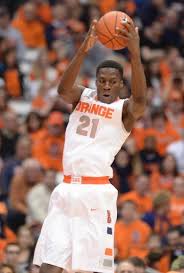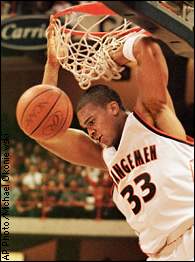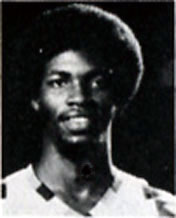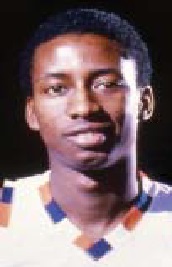In 2007, OrangeHoops inducted its charter class into the
OrangeHoops Hall of Fame: Dave Bing, Derrick Coleman, Sherman Douglas, Vic
Hanson, and Pearl Washington. The next eight years saw the addition of Billy
Owens (2008), Billy Gabor (2009), Lawrence Moten (2010), Louis Orr (2011),
Roosevelt Bouie (2011) John Wallace
(2012), Rony Seikaly (2013), Vinnie
Cohen (2014) and Etan Thomas (2015). So
the list now stands at 14. Another year has passed, and now it is time for the
2016 inductee.
I established my rules for the OrangeHoops Hall of Fame back
in 2007 and you can catch up on them here. 2016 does have six new eligible candidates
(using the fifteen year rule): Allen Griffin, Damone Brown, Rob McClanaghan,
Tim Byrnes, Chris Schau, Mike Rosenblum
Allen Griffin was a four year player for the Orangemen with
an unusual career. His freshman year he
was a reserve guard playing in all but one game. His sophomore year he was the starting
shooting guard, rotating playing time with Tony Bland and Preston
Shumpert. He would lose his starting
position his junior season. While he still played over 10 minutes a game, he
was behind Tony Bland, Preston Shumpert, Jason Hart and DeShaun Williams on the
depth chart. When Hart graduated,
Griffin would move back into the starting lineup as the point guard, and would
play more minutes than any other player that year. He would have a triple double against
Pittsburgh with 14 points, 11 assists and 10 rebounds. The next game he would score 31 points in
leading the Orangemen to an overtime win against St. John’s; Griffin would make
18 of 22 free throw in that game.
Damone Brown was a skinny forward, who developed a good mid
range jump shot, and became a decent rebounder. After playing only 53 minutes
his freshman year, he was a starter his final three years at Syracuse, and was
named Second Team All Big East his senior year.
Brown would have a brief four year career in the NBA.
Rob McClanaghan, Tim Byrnes, Chris Schau and Mike Rosenblum
were all walk-on players for Syracuse.
McClanaghan was a three year player scoring 20 points, Byrnes a one year graduate player who failed
to score, Schau a three year walk-on who failed to score, and Rosenblum a two
year walk-on who failed to score.
None of the candidates from 2000-2001 would make my top 10
candidates.
I think this year’s viable top 10 candidates come down to the
following, listed chronologically: Lew Castle, Joe Schwarzer, Lew Andreas, Jon
Cincebox, Jimmy Lee, Rudy Hackett, Leo Rautins, Rafael Addison, Stephen
Thompson, and Jason Hart.
Castle was a two time All-American at Syracuse, and was
captain and leading scorer of Syracuse’s only undefeated team, the 1913-1914
squad that went 12-0.
Schwarzer was a two time All-American, and was captain and
leading scorer of the 1917-1918 squad that went 16-1 and was retroactively
named the National Champions by the Helms Foundation.
Andreas coached Syracuse basketball for 27 seasons,
including the 19-1 1925-1926 squad that was awarded the Helms Foundation
National Championship. He had a career record of 358-134, and he was the
Syracuse Athletic Director for 28 years (1937-1964).
Cincebox was on the best rebounders in Syracuse history (in
an era when rebounding numbers were admittedly high). He helped Syracuse to the NCAA Elite Eight in
1956-1957, as the dominant big man for the Orangemen.
Lee was a clutch shooter with terrific perimeter range, and
outstanding free throw shooting ability. He was able to use his shooting
ability to set himself up as a solid passer. Lee's 18 foot jumper with five
seconds remaining led the Orangemen to beat heavily favored North Carolina, as
the Orangemen eventually moved on to their first NCAA Final Four. Lee would end
up making the All-Tournament team for his outstanding performances.
Hackett was a powerful forward who could run the court well.
He was a great rebounder and terrific scorer near the hoop. He led the Orangemen in scoring his senior
year and helped lead Syracuse to its first Final Four in 1975.
Rautins was a terrific ball-handling forward with a nice
shooting touch, solid rebounding and scoring skills. He is most well known for
his game winning tip in basket to win the Big East Championship in triple
overtime against Villanova in 1981.
Rautins also recorded two triple-doubles in Big East action.
Addison was a gangly small forward who earned a reputation
for being one of the most underrated players in the country. He possessed an excellent mid range jump
shot, was decent passing the ball, and was a solid free throw shooter. He led
the team in scoring his sophomore and junior seasons. He moved to shooting guard his senior year,
and his 6’7” height helped with the mismatches. Unfortunately a leg injury impacted his effectiveness the second half of
the season.
Thompson was an explosive swingman, with incredible
quickness and vertical leap, and excellent defensive skills. He was extremely
adept at playing above the basket though he was only about 6'2". He teamed
with Sherman Douglas to perfect the alley-oop basket. Thompson was an extremely proficient scorer,
despite the fact he was a terrible perimeter shooter.
Hart was a speedy defensive point guard, and a four year starter. He was a decent ball handler, and finished his career as the number two assist man all time at Syracuse. He was much better on the defensive end, and would finish as SU's all-time leader in steals. Hart would have a 9 year career in the NBA, mostly as a backup guard.
All are worthy players, and tough selections to make. I designed my selection rules to make it tough;
the Hall of Fame should be the 'best of the best', and I would rather have a
line of worthy players outside the Hall of Fame, than cheapen it by having
lessor players included.
This may be the toughest pick for me in all the years so
far. Ten very good candidates, and a
couple of those players are among my all-time personal favorites. My 2016 inductee is Joe Schwarzer.
 |
| Joe Schwarzer |
Joe Schwarzer was the star of the Orangemen from 1916 to
1918. He was a two time All American and
an excellent ball handler. In that era, the center position did much of the
ball handling on offense, as the ball moved through that position before being
passed to other players. He was also the
best free throw shooter on the team, earning the distinction of being the
designated free throw shooter his senior year.
He led the team to a 16-1 record his senior year, and the team was
recognized as the best team in the country by the Helms Foundation. He is considered Syracuse's best all-around
basketball player prior to Vic Hanson’s arrival.
Schwarzer was an excellent all-around athlete. He lettered
four times in football as an End (wide receiver), and earned All-American
status his senior year. He also lettered in baseball. Schwarzer was the captain
of the basketball, baseball and football teams.
He would earn a law degree from Syracuse.
Schwarzer passed away in 1989.
Congratulations to Joe Schwarzer, the OrangeHoops 2016 Hall
of Fame inductee.









